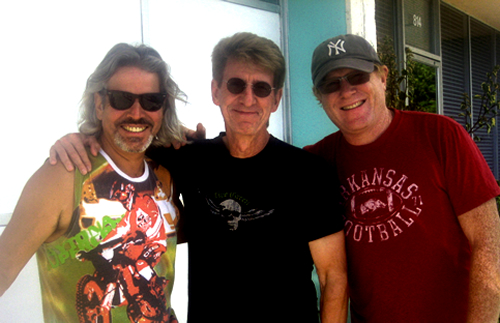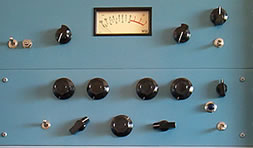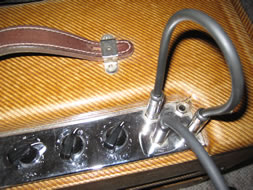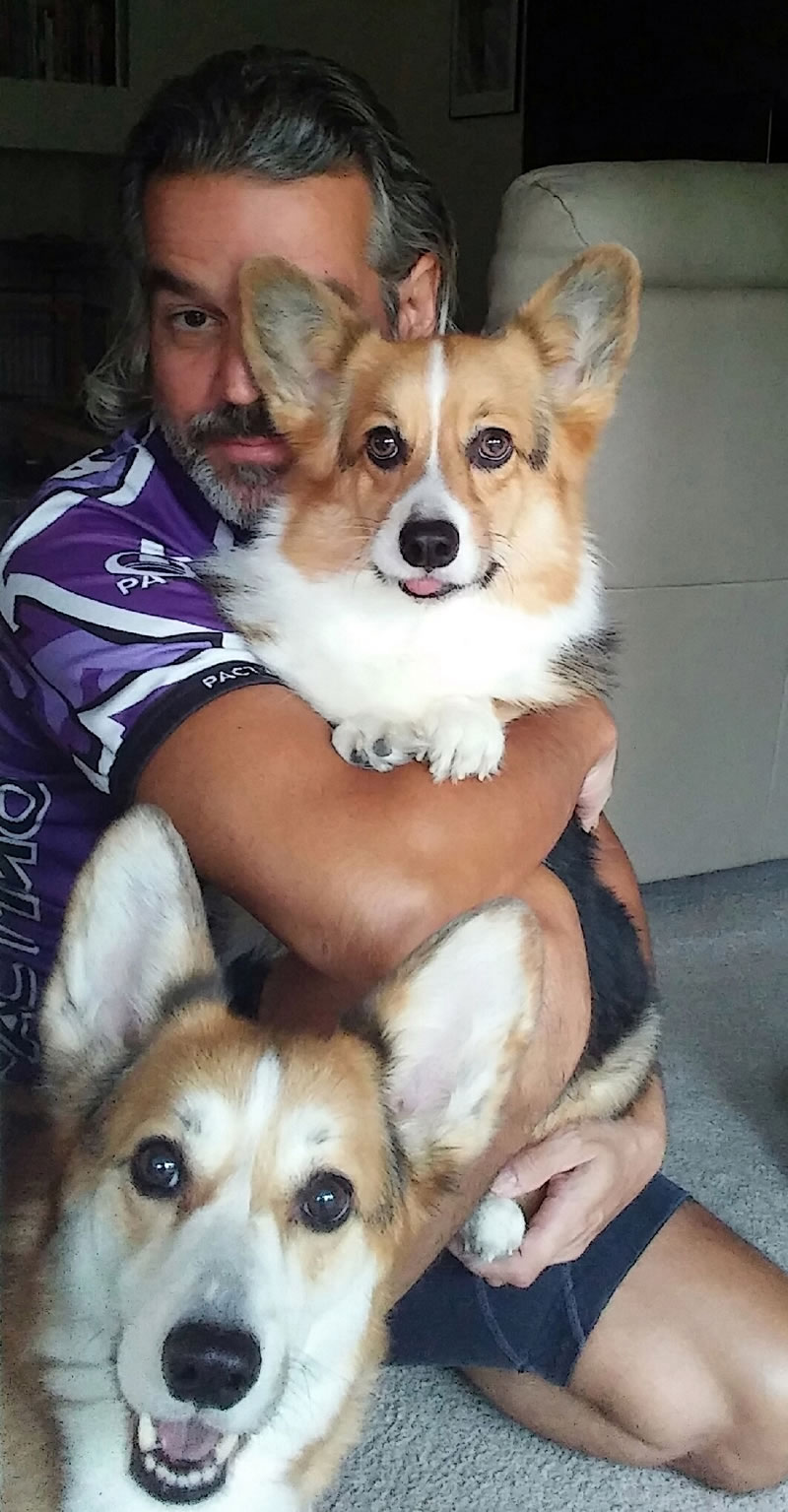RecProAudio: La2a Optical Compressor and EQP-1A Program Equalizer:

Modest notoriety was afforded me in 2004 after having reverse-engineered and built the first widely-known reproductions of the (Universal Audio) Teletronix La2a optical compressor (1968 reissue iteration) and Pulse Techniques Pultec EQP-1A program equalizer. Tip of the hat to Dave Jahnsen for his prior work on the point-to-point La2a.
Subsequently, my Teletronix La2a and Pultec EQP-1a layouts (published in 2004 under the name "Cayocosta") and launch of RecProAudio.com have contributed to the rise of classic outboard gear DIY reproductions undertaken by electronics hobbyists and musicians around the world.
RecProAudio.com facilitates the free distribution of all the information I have accumulated in the research and reproduction of the La2a, Pultec and additional outboard equipment.
(More information can be found at the RecProAudio Teletronix La2a page and Pultec EQP-1A page.)
Tweed Deluxe Speed Shop:
A guitarist for more years than I care to admit, I built my first Tweed Deluxe clone back in 2001; however, unhappy with the response and tone of the stock assembly I continued to break down and rebuild the amp using different components and various modifications over several years, until finally arriving at the sound I originally anticipated from the circuit in the first place - that of the classic recordings from (among others) Steely Dan (Larry Carlton), Neil Young and Don Felder (Eagles), those of which that are understood to be recorded with such amplifiers. After having decoded the "DNA" for vintage tonal success, in the spring of 2010 I decided to offer my 5E3 re-creations to others likewise in search of authentic performance and opened the Speed Shop.
(Legacy information on my first Deluxe, including video demos and mp3 tracks are available at the original RecProAudio Tweed Deluxe page. Likewise, information on my Low-Pass Mod, or high-cut tone control modification can be found at the Tweed Deluxe Low-Pass Mod page.)
Studio Recording:

Peter Frampton recently had this to say, "My all-time favorite amp at the moment is the Tweed Deluxe. That amp can just about handle anything. You turn it down and it’s clean and it’s beautiful. You turn it up over “3” and it starts to distort in a most beautiful way."
The Deluxe is a wonderful studio amplifier due in part to its ability to cover so much musical territory so well. Used frequently on recordings performed by luminaries such as those mentioned-above plus many more, the 5E3 circuit has long been regarded as a perfect amplifier/instrument for guitarists covering Jazz, Rock, Blues, R&B as well as many other musical styles and sub-genres.
Of particular interest to me, is the ability of the Deluxe to deliver the most organic, stinging, blues-rock overdriven tone.
Another session plus for the Deluxe is the fact that it isn't very loud when turned-up, so overdriven tones won't necessarily result in a knock on the door when working in home studios.
Outliers:
Just because an amp is vintage does not mean that it's going to sound great - in fact, many sound terrible. Moreover, the truth is that those rare "special" amplifiers are actually outliers - deviations from the norm. What contributes to their superior performance as opposed to their production standard are likewise deviations - from the averages in so far as component values (via drift and tolerances) and their subsequent affect on performance characteristics. Thus, a great vintage amp relies heavily on luck of the draw - and can be subject to changes in characteristics over time.
I found this out when I built my first Tweed Deluxe; as described above, it didn't sound like I had expected it to and I was very disappointed. So I set out to remedy the situation by reading all I could find about the 5E3 Deluxe amp and experimenting with components and their values. The result of which is the Studio-Series Deluxe, which is a direct copy of my original modified 5E3. It sounds like a great vintage amp and accommodates both single coils and humbuckers beautifully.
Tuning Vintage Amplifiers Circuits:

The biggest problem I encounter with vintage amps is that the frequency response is such that, as volume is increased certain frequencies predominate, which gives rise to bad tone that eventually caps the "usable" gain at a point well below maximum, rendering all the range in-between completely wasted. As such, folks often resort to workarounds that compromise the amp's true potential - like using gain pedals to shift the response and/or facilitate use of the amplifier within its "safe" range. This is what you are most likely going to get with a "stock" 5E3 build - either in DIY form or sourced via a "boutique" vendor; and to me, that's akin to placing a rev limiter at just 50% of a racing motor's full tolerance, as the best part of the amplifier's operational range - the area where its true character resides - is off-limits.
In any event, it doesn't have to be this way. Frequency response can be tuned and voltages modified slightly to open up access to the complete range of the amplifier's gain. The result being an amp that no longer protests higher gain settings with the introduction of tonal artifacts or flabbing speakers, but rather one that increasingly sings in its true vintage voice as the dial delves further into the higher numbers. This is what I provide.
Furthermore, at lower gain settings the tone of a properly tuned amp is more apt described as restrained, rather than pushed - in other words, at early breakup you're getting a hint of it's full-blown singing tone, rather than the tell-tale raggedness that is warning not to push-on much further. The difference, distilled, is sweetness as opposed to harshness.
Philosophy:
Just about anyone can build a Tweed Deluxe circuit; but few do it very well, and fewer still can assemble an amp that performs as expected when overdriven - as the best original Deluxes do - especially without losing any of the amp's normal operational characteristics.
When operating below overdrive levels it's easy for just about any 5E3 circuit to sound nice, but when the volume is increased the tone can often be awful - flabby bass, fizzy highs, splotchy distortion and phase issues can plague even the cleanest builds; and sorting out these problems can take a long time. For me, it took a few years, many rebuilds and many dollars before I was finally happy with what I was hearing.
I only do one thing: 5E3 Deluxes; and I think it's safe to say that I've done more research over the last several years regarding the Tweed Deluxe circuit and it's application in studio recording than just about anyone else. What I was after was that classic tone of ZZ Top's Billy Gibbons, Larry Carlton (Steely Dan) and Don Felder (Eagles); what I learned was that simply building a "stock" circuit will not get you there. Why? Because of differences in voltages, passive componentry, transformers, tolerances, lead dress, and more - plus all of the aforementioned factors combined.
Tweed Deluxes should sing and rock, and they do just that when sorted out and built right; though you'd never know that by checking out demos on YouTube as nearly everyone plays the same old chicken pickin', clean blues and rockabilly riffs. Nothing wrong with that stuff, but (as popular music history has illustrated) this amp is capable of so much more, yet (alarmingly) nobody today seems to acknowledge it - including most builders.
So, I suppose what I'm saying here is: if you want an amp that's built and tested to deliver vintage Tweed Deluxe rock and roll tone (while retaining all the other attributes of Fender's late tweed era) you'd do well to consider my work.
There are tons of mp3s and videos located at RecProAudio recorded by me with my Deluxe clones. Please check them out at your convenience.
(Reproductions of classic recording studio outboard gear - Universal Audio Teletronix La2a and Pulse Techniques EQP-1a - were utilized in studio recordings.)
Detail and Investment:
Paying very close attention to detail, I build each chassis personally (as if I were building it for myself) while utilizing only the finest components available anywhere; including those by Kendrick (Gerald Weber), Mercury Magnetics, Sozo, Allen-Bradley (NOS), Amphenol (NOS), CTS, additional NOS and more. Moreover, hand assembly in the USA by an accomplished studio musician and electronics enthusiast renown for quality engineering and workmanship helps ensure outstanding secondary market value and return on investment.
Operating voltages are inline with vintage mains, and output transformers are 1960 specifications. No variac is required, as B+ is optimized to provide maximum performance and valve longevity.
Interestingly, considering that many original Deluxes have had cap jobs and replacement output transformers installed, the vintage-series Deluxes, carefully assembled with NOS, OEM and otherwise high-quality parts are really only differentiated from such an original's electronic DNA by virtue of the power transformer and pots (both of which being stood-in-for by very similar modern equivalents) and a standby (very sensibly) replacing the outmoded ground switch.
To assure premier mechanical and tonal performance, all builds are tested, optimized and burned-in by me personally (in my home studio).
Photos, build notes and demo videos may be published (on this site) for each individual chassis.
Each chassis is signed and numbered by me.
Vintage vs. Studio Series Versions:
Although both series versions perform and record exceptionally well, I prefer and use the Studio-Series version as it just does it all: ZZ Top, the Dan, Eagles, as well as shades of SRV and Hendrix; and of course, that wonderful, glassy, clean tone is always there.
Vintage-Series amplifiers are intended for those that wish to have an incredibly accurate reproduction of the stock 5E3 amplifier; a model perhaps better suited to players that are most interested in less aggressive operational settings. Not that they don't overdrive well - as I most certainly make sure that they do - they just aren't quite as good at it as the modified Studio-Series models are.
The Tweed Deluxe Journey - Follow Its Lead:
The key with the Tweed Deluxe is to follow its lead. Like many amps, you can't force it to do something it doesn't want to do. A poorly built 5E3 doesn't want to take you anywhere, but a great Deluxe will open doors and take you places where you will find yourself inspired to play for hours on end with new discoveries around every corner.
As such, if you've never played a good one, you've never really played a Deluxe.
Summary:
If you can't crank up the amp and smile at what you hear and feel, then you're not experiencing the real thing. I provide amplifiers that will do this for you.
Please feel free to contact me with any questions or comments.
Best,


Based in Southwest Florida, USA, RecProAudio's Tweed Deluxe Speed Shop is dedicated to offering the finest quality, best sounding vintage reproduction and custom tuned Fender 5E3 amplifiers.


Tweed Deluxe Speed Shop | PO Box 855 | Sanibel, FL 33957 ![]()
Landline: 239-689-5941 (do not text)
Other RecPro Audio Sites:
Pultec EQP-1a Kit |
RTB Preamp | RTB Compressor
Legacy DIY Site: RecProAudio
Copyright © 2010 - 2025 RecPro Audio - All Rights Reserved
Website by Rondo